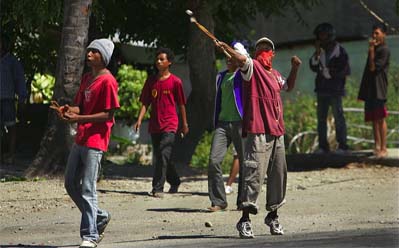This is largely where the lesson ended. Most analysis of this period, curiously, focuses on the events of April to June 2006. This is reflected in the much quoted casualty figures of 37 fatalities, which was the tally after the bloodletting between the police and army ended in May 2006. Some reports don’t even mention the violence of 2007 at all, and yet the conflict ran for another 18 months. According to UNMIT estimates, in 2007, over 100 people died in the January to October period alone. This gap in understanding of that conflict is highly revealing of the gap in knowledge about East Timorese society itself.
There were two distinct phases in the conflict between two different sets of antagonists. While the first phase in 2006 featured broad regional and ethno-linguistic divisions, the second phase was characterised by conflict between villages and families, the most basic unit of East Timorese society. There are a number of implications for peace-keeping and peace-building as a consequence.
The patterns of conflict of this second phase, for example, showed a strong symmetry between gang or martial arts group and family membership. In East Timor, a village is more or less an extended family. While this nexus is strongest in the rural areas, it is also highly prevalent in the city. This overlapping nature of martial arts group or gang membership with kinship networks makes mediation and policing highly complicated, also making it difficult to distinguish between a gang conflict or a communal conflict. In many cases it is both.
Also, East Timorese urban neighbourhoods, especially in the densely packed areas to the west of the city with high rural migrant populations, are a complex patchwork of often competing ethno-linguistic groups. Traditional leaders are habitually included in mediation processes, but some may have authority over only a small area or group, or no authority at all. Circular rural urban population movements mean that such urban centres are fluid and dynamic, and that authority is sometimes ephemeral at best. In many cases, real traditional authority actually resides in a group’s rural district of origin.
Sometimes there is even confusion about who is being mediated, or which dispute is being mediated. Some village heads have commented that in some instances, villages were mediated who were not even in conflict. Some also observed that while the issues surrounding the east/west conflict of 2006 were mediated (at least temporarily) issues arising from the 2007 conflict had not been. Therefore, some communities have accepted internally displaced families back from the first phase, but not from the second phase. As many as 45 per cent of returnees in one area of Dili have faced continued conflict as a consequence.
There are implications for policing too. International police have often described their frustration in locating conflict sites and discerning between victims and perpetrators. Most agreed that more detailed local knowledge would enable them to be more efficient and discerning in their responses. Unfortunately, as they admit, with such high rotation of international police and army personnel, valuable institutional knowledge is not always retained.
The situation is stable now, but only if stability can be measured as lack of conflict. If civil society and the security forces are to be more effective in their response next time around, there will need to be a deeper ethnographic or evidence based understanding of the cultural and social dynamics of East Timorese society, especially of contemporary urban settings. Current state-centric and donor-driven approaches to policing, justice and development have also so far proven inadequate. During the conflict of 2006-7, 1300 international security forces and an army of international aid workers did little more than stem the level of violence, but could not stop it. That it ended was a decision taken by East Timorese themselves. Therefore, the solution must ultimately come from the community itself.
Listen to the audio of James’ presentation held on August 31 at ANU.
James Scambary is a Research Fellow at the Swinburne Institute of Social Research.


Dear James Scambary
I am very critical about your statement “Urban conflict in East Timor”. East Timor was and always a pacific country we have some conflict among martial arts group or gang membership. It is happen around world. It is not new and it is not surprise for us. I was there during the crises 2006 there was not intense communal conflict that engulfed East Timor between 2006 and 2007 this information is purely invention and bias toward East Timor.
The conflict of East Timor was a coup de etat created and fomented for external forces to overtrow the elected government. I am ready to discuss with you any matter related to East Timor.
Raul Mousaco,
Totally agree with you. Based on our history, all conflicts the country has been through are simply conflicts created by external forces, timorese always ended up being the victims..
Just for the record, I was also there in 2006 and there was fighting outside my house in Bairro Pite nearly every night for the entire year, as there was in many other suburbs. This is reflected in every UNPOL security update for 2006-7. Regarding the conflict of 2007, UNPOL figures, compiled from documented reports where UNPOL forces had responded to incidents, show up to 50 group fighting incidents per week nationally all the way through the year, and 150 deaths as a result of this fighting, which is not counting conflict related murders and assaults by individuals or small groups. If anything, the conflict is under reported, given the difficulties of responding to every incident. There are also a number of publicly available donor reports, with detailed maps and statistics, showing the extent of damage and social dislocation from rural conflict during that time in hot spots like Uatolari. If it is an invention, it is certainly a very sophisticated one.